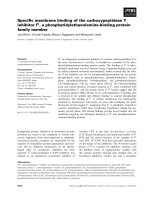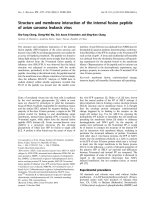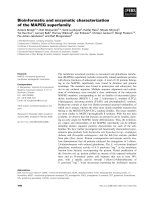Báo cáo khoa học: "FLECTIONS ON TWENTY YEARS OF THE ACL" doc
Bạn đang xem bản rút gọn của tài liệu. Xem và tải ngay bản đầy đủ của tài liệu tại đây (294.59 KB, 3 trang )
P~FLECTIONS ON TWENTY YEARS OF THE ACL
Jonathan Allen
Research Laboratory of Electronics
and
Department of Electrical Engineering and Computer Science
Massachusetts Institute of Technology
Cambridge, MA 02139
I entered the field of computational
linguistics in 1967 and one of my earliest
recollections is of studying the Harvard Syntactic
Analyzer. To this date, this parser is one of the
best documented programs and the extensive
discussions cover a wide range of English syntax.
It is sobering to recall that this analyzer was
implemented on an IBM 7090 computer using 32K
words of memory with tape as its mass storage
medium. A great deal of attention was focussed
on means to deal with the main memory and mass
storage limitations. It is also interesting to
reflect back on the decision made in the Harvard
Syntactic Analyzer to use a large number of parts
of speech, presumably, to aid the refinement of
the analysis. Unfortunately, this introduction of
such a large number of parts of speech
(approximately 300) led to a large number of
unanticipated ambiguous parsings, rather than
cutting down on the number of legitimate
parsings as had been hoped for. This analyzer
functioned at a time when revelations about the
amount of inherent ambiguity in English (and other
natural languages) was a relatively new thing and
the Harvard Analyzer produced all possible
parsings for a given sentence. At that time, some
effort was focused on discovering a use for all
these different parsings and I can recall that one
such application was the parsing of the Geneva
Nuclear Convention. By displaying the large
number of possible interpretations of the
sentence, it was in fact possible to flush out
possible misinterpretations of the document and
I believe that some editing was performed in order
to remove these ambiguities.
In the late sixties, there was also a
substantial effort to attempt parsing in terms of
a transformational grammar. Stan Petrick's
Doctoral Thesis dealt with this problem, using
underlying logical forms very different from those
described by Chomsky, and another effort at Mitre
Corporation, led by Don Walker, also built a
transformational parser. I think it is signifi-
cant that this early effort at Mitre was one of
the fJr=~ examples where linguists were directly
involved in computational applications.
It is in=cresting that in the development of
syntax, from the perspective of both linguists and
computational linguists, there has been a
continuing need to develop formalisms that
provided both insight, as well as coverage. I
think these two requirements can be seen both in
transformational grammar and the ATN formalism.
Thus, transformational grammar provided a simple,
insightful base through the use of context-free
grammar and then provided for the difficulties of
the syntax by adding on to this base the use of
transformations and of course, gaining turing
machine power in the process. Similarly, ATNs
provided the simple base of a finite state machine
and added to it turing machine power through the
use of actions on the arcs. It seems to be
necessary to provide some representational means
that is relatively easy to think about as a base
and then contemplate how these simpler base forms
can be modified to provide for the range of actual
facts of natural language.
Moving to today's emphasis, we see increased
interest in psychological reality. An example of
this work is'the thesis of M itch Marcus, which
attempts to deal with constraints imposed by
human performance, as well as constraints of a
more universal nature recently characterized by
linguists. This model has been extended further
by Bob Berwick to serve as the basis for a
learning model. Another recent trend that causes
me to smile a little is the resurgence of interest
in context free grammars. I think back to Lyons'
book on theoretical linguistics where context free
grammar is chastised as was the custom, due to its
inability to insightfully characterize subject-
verb agreement, discontinuous constituents, and
other things thought inappropriate for context
free grammars. The fact that a context free
grammar can always characterize any finite segment
of the language was not a popular notion in the
early days. Now we find increasing concern with
efficiency arguments, and also due to the
increasing emphasis in trying to find the simplest
possible grammatical formalism to describe the
facts of language, a vigorous effort to provide
context free systems that provide a great deal of
coverage. In the earlier days, the necessity of
introducing additional non-terminals to deal with
problems such as subject-verb agreement was seen
as a definite disadvantage, but today such
criticisms are hard to find. An additional trend
that is interesting to observe is the current
emphasis on ill-formed sentences which are now
recognized as valid exemplars of the language and
with which we must deal in a variety of
computational applications. Thus, there has been
attention focused on relaxation techniques and the
104
ability to parse limited phrases within discourse
structures that may be ill-formed.
In the early days of the ACL, I believe that
computation was seen mainly as a tool used to
represent algorithms and provide for their
execution. Now there is a much different emphasis
on computation. Computing is seen as a metaphor,
and as an important means to model varioUs
linguistic phenomena, as well as more broadly
cognitive phenomena. This is an important trend,
and is due in part to the emphasis in cognitive
science on representational i§sues. When we must
deal representations explicitly, then the branch
of knowledge that provides the most help is
computer science, and this fact is becoming much
more widely appreciated, even by those workers
who are not focused primarily on computing. This
is a healthy trend, I believe, but we need also to
be aware of the possibility of introducing biases
and constraints on our thinking dictated by our
current understanding and view of computation.
Since our view of computation is in turn condi-
tioned very substantially by the actual computing
technology that is present at any given time, it
is well to be very cautious in attributing basic
understanding of these representations. A
particular case in point is the emphasis, quite
popular today, on parallelism. When we were used
to thinking of computation solely in terms of
single-sequence Von Neumann machines, then
parallelism did not enjoy a prominent place in
our models. Now that it is possible technologi-
cally to implement a great deal of parallelism,
one can even discern more of a move to breadth
first rather than depth first analyses. It seems
clear that we are still very much the children of
the technology that surrounds us.
I want to turn my attention now to a
discussion of the development of speech processing
technology, in particular, text-to-speech
conversion and speech recognition, during the last
twenty years. Speech has been studied over many
decades, but its secrets have been revealed at a
very slow pace. Despite the substantial in fusion
of money into the study of speech recognition in
the seventies, there still seems to be a natural
gestation period for achieving new understanding
of such complicated phenomena. Nevertheless,
during these last twenty years, a great deal of
useful speech processing capability has been
achieved. Not only has there been much achieve-
ment, but these results have achieved great
prominence through their coupling with modern
technology. The outstanding example in speech
synthesis technology has been of course the Texas
Instruments Speak and Spell which demonstrated for
the first time that acceptable use of synthetic
speech could be achieved for a very modest price.
Currently, there are at least 20 different
integrated circuits, either already fabricated or
under development, for speech synthesis. So a
huge change has taken place. It is possible today
to produce highly intelligible synthetic speech
from text, using a variety of techniques in
computational linguistics, including morphological
analysis, letter-to-sound rules, lexical stress,
syntactic parsing, and prosodic analysis. While
this speech can be highly intelligible, it is
certainly not very natural yet. This reflects in
part the fact we have been able to determine
sufficient correlates for the percepts that we
want to convey, but that we have thus far been
unable to characterize the redundant interaction
of a large variety of correlates that lead to
integrated percepts in natural speech. Even such
simple distinctions as the voiced/unvolced
contrast are marked by more than a dozen different
correlates. We simply don't know, even after all
these years, how these different correlates are
interrelated as a function of the local context.
The current disposition would lead one to hope
that thls interaction is deterministic in nature,
but I suppose there is still some segment of the
research community that has no such hopes. When
the redundant interplay of correlates is properly
understood, I believe this will herald a new
improvement in our understanding needed for high
performance speech recognition systems. Neverthe-
less, it is important to emphasize that during
these twenty years, commercially acceptable text-
to-speech systems have become viable, as well as
many other speech synthesis systems utilizing
parametric storage or waveform coding techniques
of some sort.
Speech recognition has undergone a lot of
change during this period also. The systems that
are available in the marketplace are still based
exclusively on template matching techniques,
which probably have little or nothing to do with
the intrinsic nature of speech and language. That
is to say, they usa some form of informationally-
reduced representation of the input speech wave-
form and then contrive to match this representa-
tion against a set of stored templates. Various
techniques have been introduced to improve the
accuracy of this matching procedure by allowing
for modifications of the input representation or
the stored templates. For example, the use of
dynamic programming to facilitate matching has
been very popular, and for good reason, since its
use has led to improvements in accuracy of
between 20 and 30 percent. Nevertheless, I
believe that the use of dynamic programming will
not remain over the long pull and that more
phonetically and linguistically based techniques
will have to be used. This prediction is
predicated, of course, on the need for a huge
amount of improved understanding of language in
all of its various representations and I feel that
there is need for an incredibly large amount of
new data to be acquired before we can hope to
make substantial progress on these issues,
Certainly an important contribution of computa-
tional linguistics is the provision of instru-
mental means to acquire data, In my view, the
study of both speech synthesis and speech
recognition has been hampered over the years in
large part due to the sheer lack of insufficient
data on which to base models and theories. While
we would still like to have more computational
power than we have, at present, we are able to
provide highly capable interactive research
environments for exploring new areas. The fact
that there is none too much of these computational
resources is supported by the fact that the speech
105
recognition group at IBM is, I believe, the
largest user of 370/168 time at Yorktown Heights.
An interesting aspect of the study of speech
recognition is that there is still no agreement
among researchers as to the best approach. Thus,
we see techniques based on statistical decoding,
those based on template matching using dynamic
programming, and those that are much more phonetic
and linguistic in nature. I believe that the
notion, at one time prevalent during the
seventies, that the speech waveform could often be
ignored in favor of constraints supplied by
syntax, semantics, or pragmatics is no longer held
and there is an increasing view that one should
try to extract as much information as possible
from the speech waveform. Indeed, word boundary
effects and manifestations at the phonetic level
of high level syntactic and semantic constraints
are being discovered continually as research in
speech production and perception continues. For
all of our research into speech recognition, we
are still a long ways away from approximating
human speech perception capability. We really
have no idea as to how human listeners are able to
adapt to a large variety of speakers and a large
variety of communication environments, we have no
idea how humans manage to reject noise in the
background, and very little understanding as to
the interplay of the various constraint domains
that are active. Within the last five years,
however we have seen an increasing level of
cooperation between linguists, psycholinguists
and computational linguists on these matters and
I believe that the depth of understanding in
psycholinguisties is now at a level where it can
be tentatively exploited by computational
linguists for models of speech perception.
Over these twenty years, we have seen
computational linguistics grow from a relatively
esoteric academic discipline to a robust
con~ercial enterprise. Certainly the need within
industry for man-machlne interaction is very
strong and many computer companies are hiring
computational linguists to provide for natural
language access to data bases, speech control of
instruments, and audio announcements of all sorts.
There is a need to get newly developed ideas into
practice, and as a result of that experience,
provide feedback to the models that computational
linguists create. There is a tension, I believe,
between, on the one hand, the need to be far
reaching in our research programs vs. the need
for short-term payoff in industrial practice. It
is important that workers in the field seek to
influence those that control resources to maintain
a healthy balance between these two influences.
For example, the relatively new interest in
studying discourse structure is a difficult, but
important area for long range research and it
deserves encouragement, despite the fact that
there are large areas of ignorance and the need
for extended fundamental research. One can hope
however, that the demonstrated achi~vp~nt of
computational linguistics over the last twenty
years will provide a base upon which society will
be willing to continue to support us to further
explore the large unknowns in language competence
and behavior.
106









